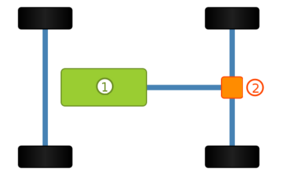Two-wheel drive facts for kids
Two-wheel drive (often called 2WD) is a way that vehicles get power to their wheels. In a 2WD system, the engine sends power to only two of the vehicle's wheels at the same time. These two wheels are usually on the same axle, which is like a rod connecting two wheels. Most cars and trucks you see on roads and highways use two-wheel drive.
There are two main types of two-wheel drive:
- Front-wheel drive (FWD): The engine powers the front two wheels.
- Rear-wheel drive (RWD): The engine powers the back two wheels.
When a vehicle starts to move quickly, some of its weight shifts to the back. This shift helps rear-wheel drive cars get better grip on the road. Two-wheel drive systems are simple and strong. This is why many police cars and other service vehicles use rear-wheel drive.
Contents
How Wheels Turn (Differentials)
Cars need to turn corners smoothly. When a car turns, the outside wheels have to spin faster than the inside wheels. If all wheels spun at the same speed, turning would be very hard.
To solve this, two-wheel drive vehicles have a special part called a differential. This part is usually in the rear axle. The differential lets one wheel turn faster than the other when you go around a corner. This also helps prevent the tires from wearing out too quickly.
However, this also means that at any given moment, often only one of the two drive wheels is getting most of the power.
Two-Wheel Drive in Different Conditions
The type of two-wheel drive can affect how a vehicle handles, especially in bad weather.
Rear-Wheel Drive (RWD) Challenges
Rear-wheel drive cars can have trouble on wet or slippery roads. Since only one of the two drive wheels might be getting power at a time, the tires can lose their grip easily. This makes it harder to control the car.
Front-Wheel Drive (FWD) Advantages
Front-wheel drive vehicles generally have better grip on slippery surfaces. This is because the engine's weight is over the front wheels, which helps them push the car forward. However, even FWD cars are not as good as four-wheel drive vehicles in snow or icy conditions. Four-wheel drive sends power to all four wheels, giving much more grip.
See also
 In Spanish: Tracción en dos ruedas para niños
In Spanish: Tracción en dos ruedas para niños


